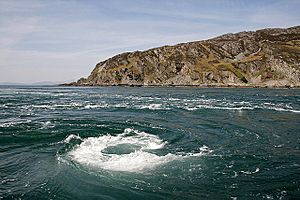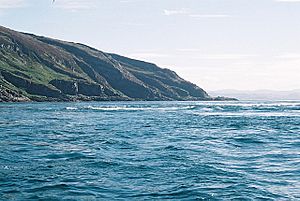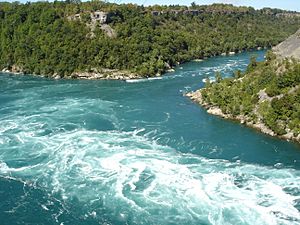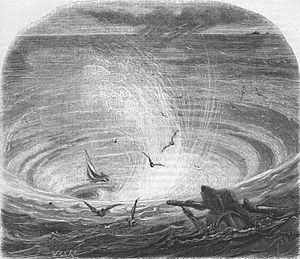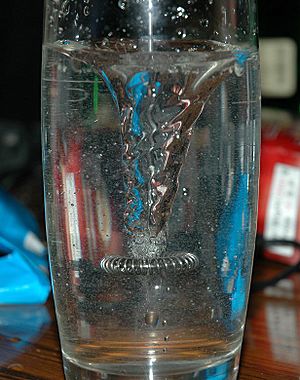Whirlpool facts for kids
A whirlpool is a swirling body of water. It forms when currents of water crash into each other or when water hits an obstacle. You might see small whirlpools when water drains from a bath or sink. Bigger, more powerful whirlpools found in seas or oceans are sometimes called maelstroms. The word vortex is the correct term for a whirlpool that pulls water downwards.
In narrow ocean channels with fast-moving water, whirlpools often happen because of tides. Many old stories talk about ships being pulled into a maelstrom. However, usually only smaller boats are truly in danger. Smaller whirlpools can also be seen in river rapids. They also appear downstream from man-made structures like weirs and dams. Even large waterfalls, like Niagara Falls, create strong whirlpools.
Contents
Famous Whirlpools Around the World
Saltstraumen: A Powerful Tidal Current
Saltstraumen is a narrow channel in Norway, near the Arctic Circle. It is about 33 kilometers (20 miles) southeast of the city of Bodø.
This strait has one of the strongest tidal currents on Earth. When the current is at its fastest, whirlpools can form. These can be up to 10 meters (33 feet) wide and 5 meters (16 feet) deep!
Moskstraumen: Norway's Giant Swirl
The Moskstraumen is a unique system of whirlpools. It is found in the open sea near the Lofoten Islands off the coast of Norway. This is the second strongest whirlpool in the world. Its currents can reach speeds of up to 32 kilometers per hour (20 mph). People believe this is the whirlpool shown on an old map by Olaus Magnus from 1539. He called it "Horrenda Caribdis."
The Moskstraumen forms because of strong daily tides. Also, the seabed here has an unusual shape. There is a shallow ridge between the Moskenesøya and Værøy islands. This shape makes the tidal currents stronger and causes them to swirl.
Writers like Edgar Allan Poe and Jules Verne have written fictional stories about the Moskstraumen. They described it as a huge swirling hole that reaches the bottom of the ocean. In reality, it is a set of strong currents and crosscurrents. Poe's short story "A Descent into the Maelström" (1841) was the first time the word maelstrom was used in English. In his story, two fishermen are caught by the maelstrom, but one survives.
Corryvreckan: Scotland's Roaring Whirlpool
The Corryvreckan is a narrow strait in Scotland. It lies between the islands of Jura and Scarba. This is the third-largest whirlpool in the world. When the tides come in, the waters of Corryvreckan can create waves over 9 meters (30 feet) high. The roar of this maelstrom can be heard up to 16 kilometers (10 miles) away. Its currents can reach speeds of 18 kilometers per hour (11 mph). The Royal Navy once called it "extremely dangerous."
A team making a documentary once threw a mannequin into the Corryvreckan. The mannequin had a bright vest and a depth gauge. The whirlpool pulled it down and then spat it out far away. The depth gauge showed it had gone down 262 meters (860 feet). It also looked like it had been dragged along the bottom.
Niagara Whirlpool: A Famous Landmark
About 4.8 kilometers (3 miles) downstream from Niagara Falls is the Niagara Whirlpool. Most of this whirlpool is in Canada, but part of it is in the United States. You can cross over it on the Whirlpool Aero Car.
The basin of the whirlpool is 518 meters (1,700 feet) long and 365 meters (1,200 feet) wide. The water here can be as deep as 38 meters (125 feet).
Other Notable Maelstroms and Whirlpools
The Old Sow whirlpool is between Deer Island, New Brunswick, Canada, and Moose Island, Eastport, Maine, USA. It is called "pig-like" because it makes a screeching noise when it's strongest. Its currents can reach speeds of 27.6 kilometers per hour (17.1 mph). The smaller whirlpools around it are called "Piglets."
The Naruto whirlpools are in the Naruto Strait near Awaji Island in Japan. Their currents can reach speeds of 26 kilometers per hour (16 mph).
Skookumchuck Narrows is a tidal rapids in British Columbia, Canada. It forms whirlpools with currents over 30 kilometers per hour (19 mph).
French Pass is a narrow and tricky stretch of water in New Zealand. In 2000, a whirlpool there caused a dangerous situation for student divers.
A short-lived whirlpool formed in Lake Peigneur in Louisiana, United States, on November 20, 1980. This happened after a drilling accident. The lake then drained into a salt mine below it. This was not a natural whirlpool. It caused a lot of damage, including the loss of boats and land.
More recently, in June 2015, a whirlpool formed in Lake Texoma on the Oklahoma–Texas border. This happened near the dam's floodgates. The lake was being drained because it had reached its highest level ever.
Dangers of Whirlpools
Strong whirlpools have caused harm to sailors, but their power is often exaggerated in stories. One of the few real reports of a big disaster comes from the 14th century. The ruler Mansa Musa of the Mali Empire sent out 200 boats to explore the ocean. Only one boat returned. Its captain said they saw a huge, fast-flowing "river" in the middle of the ocean. He said other boats were pulled into a whirlpool there and never came out.
Stories by writers like Edgar Allan Poe and Jules Verne are mostly made up. However, temporary whirlpools caused by big accidents, like the Lake Peigneur disaster, have been known to pull down medium-sized boats like barges and tugboats.
Whirlpools in Stories and Culture
Besides Poe and Verne, another old story comes from the 1500s. Olaus Magnus, a Swedish bishop, wrote that a maelstrom more powerful than the one in the Odyssey pulled in ships and even whales. Pytheas, a Greek historian, also said that maelstroms swallowed ships and then spat them back out.
The monster Charybdis from Greek mythology was later thought to be a whirlpool. It was said to suck entire ships into its swirl near the coast of Sicily.
In the 8th century, Paul the Deacon described tidal surges and the maelstrom to people who were not used to such strong tides. He wrote about a very deep whirlpool called "the navel of the sea." He said it sucked in waves and then pushed them out twice a day.
Three famous literary stories about the Lofoten Maelstrom are from the 1800s. The first is "A Descent into the Maelström" (1841) by Edgar Allan Poe. The second is 20,000 Leagues Under the Sea (1870) by Jules Verne. At the end of this novel, Captain Nemo sends his submarine, the Nautilus, into the Maelstrom. The "Norway maelstrom" is also mentioned in Herman Melville's Moby-Dick.
In the Life of St Columba, the author, Adomnan of Iona, tells a story about the saint. He says Columba knew about a bishop who sailed into a whirlpool off Ireland. Columba said the Lord was scaring the bishop to make him pray harder.
The Corryvreckan whirlpool is important in the 1945 film I Know Where I'm Going!. In the movie, a woman named Joan is determined to reach an island. She offers a fisherman a lot of money to take her across dangerous waters. The whirlpool becomes a big challenge for them.
In the movie Pirates of the Caribbean: At World's End, the final battle happens inside a giant whirlpool. This whirlpool looks to be over a kilometer (0.6 miles) wide and hundreds of meters deep.
What's in a Name?
One of the first times the word maelstrom was used in English was by Edgar Allan Poe. This was in his short story "A Descent into the Maelström" (1841). The word itself comes from the Dutch word maelstrom. This means 'grinding current' or 'mill-stream'. It refers to the way water seems to grind or mill like a millstone.
See also
 In Spanish: Remolino para niños
In Spanish: Remolino para niños
- Coriolis effect
- Eddy (fluid dynamics)
- Rip current


